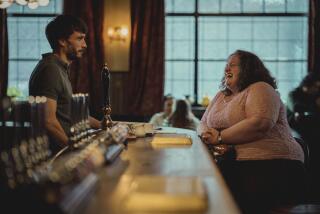Rudolph for Rent : From Their Oregon Ranch, the Gillaspie Family Provides Stand-Ins for Santa’s Famous Team
- Share via
REDMOND, ORE. — “Now, Bubba! Now, Minnie! Now, Peaches and Polly! On, Pepper, on! Ruby, on! Bo-Peep and Dolly. . . .”
Polly pulling Santa’s sleigh?
Yes, the reindeer are on the road again, spreading Yuletide cheer in shopping malls from Virginia to San Diego.
Early Christmas morning, their year’s work done, the last team will return home to their reindeer ranch here in central Oregon. Soon afterward, it will be antler-shedding season, then a summer at pasture, then breeding season, then another Santa season and another command performance impersonating Dasher, Dancer, Prancer, Vixen, Comet, Cupid, Donner and Blitzen.
And, of course, Rudolph.
Basically, theirs is a two-month annual stint. “There’s not much call for them in July,” says Mike Gillaspie, who with his wife, Cindy, manages “Operation Santa Claus.” They oversee the care and feeding of a herd of 100-plus reindeer on a 20-acre spread a few miles outside this farming community of 7,000, about 135 miles southeast of Portland.
Mike, a former teacher, laughs and says: “If anybody had told me 10 years ago that I’d be reindeer ranching. . . .”
He and Cindy, both 37 and married 10 years, have known each other since second grade. They took over management in 1984, but the ranch dates to the early ‘50s when John Zumstein of Redmond brought a small herd of reindeer from Alaska. In the ‘70s, the name, the herd and the property were acquired by Cindy’s family.
The Gillaspies’ decision to become reindeer caretakers was based partially on the lifestyle it promised: a rural setting with real neighbors and more time with their daughters, Marisa, 9, and Miranda, 7 1/2. The business is a family project, with the girls helping out in the gift shop. They also name the reindeer.
No reindeer is ever given one of the names Clement C. Moore made part of the American vocabulary with his famous poem that begins “ ‘Twas the night before Christmas.” Cindy reasons: “What do you do when Comet dies of old age?” (On the road, reindeer assume the stage names of Santa’s more famous octet.)
Through the years, the ranch has evolved from a kind of “mom and pop” operation that entered animals in local parades to reindeer supplier for such clients as Disneyland, the Los Angeles Zoo, films (“Ernest Saves Christmas,” for one) and commercials.
The Gillaspies’ lifestyle may encourage togetherness, but it does not provide privacy. Home is a ranch-style house on the reindeer ranch, which fronts Highway 126, a major east-west artery. Visitors, in the thousands annually, seem to think of the Gillaspies as part of the free exhibit.
“It’s like living in a public park,” Cindy says. “They dump their ashtrays, dirty diapers and garbage” and peek in on family back-yard barbecues. Until the Gillaspies put up a fence, she says, “People would wander through and put their kids on our swing set.” Passing motorists with car trouble consider them sort of a Triple A annex.
Sometimes, visitors will even ask them to “go catch a couple of deer” so they can pose them with their children. No way, Cindy says: “People are so sue-happy. They get a foot stepped on, get poked by an antler. . . .”
Six teams of five reindeer (four mature animals and a young “Rudolph”) are on the road now, traveling by truck and horse trailer. Each team is accompanied by two handlers who have been working with them since mid-October. All these reindeer--the Rudolphs included--are females. Mike explains that the bulls can be “very aggressive.”
Once, he says, “I had a bull get me down and take me for a 45-minute ride. About a 350-pounder. I’d slipped on the grass and he was on top of me. . . .” Cindy, up at the house, couldn’t hear his cries for help. Finally, he was able to grab an antler, grab a leg and wiggle away.
He has yet to be gored but “raking” by antlers is common. “No matter what you do with reindeer, they’re still wild,” he says. “The first rule of thumb, if you have them in close confines, is don’t ever turn your back.”
The herd numbers 102 “when everyone’s home,” as Cindy puts it. It includes a rare albino named Snowball that suffers sunburned antlers in summer; breeding bulls named Clyde, Rocky, Skippy--the orneriest of all--and Bullwinkle, and aged animals too arthritic to pull Santa’s sleigh.
“You bring Santa. We’ll do the rest,” is the Operation Santa Claus slogan. Clients provide Santa, and the Gillaspies provide the rest, including reindeer, feed, handlers, harnesses (properly inscribed “Dancer,” “Prancer” and all), sleigh and Christmas music.
Each of the teams now on the road will make about 25 stops, most of these at shopping malls where children, some curious and some skeptical, come to gawk. They want to know, of course, why Rudolph doesn’t have a red nose. The trainers have answers for the most-asked questions: Rudolph’s nose turns red “only on foggy Christmas Eves.” Santa’s reindeer are tethered “so they won’t fly away.”
Cindy, who is the reindeer booking agent and who also runs the small, on-site gift shop that purveys reindeer-abilia such as T-shirts, has had some pretty strange requests. She recalls: “Two years ago, some guy in Portland wanted to hire a full nine reindeer”--Santa’s traditional team of eight plus a Rudolph. He was going to hoist them to his rooftop with a crane, just for Christmas Eve.
Money was no object.
Request denied.
What does it cost to rent a team of reindeer? That depends on several factors, including how far the animals have to be trucked and whether it’s mid-week or a weekend. The cost can be “anywhere from $1,000 to $4,000,” Cindy says.
As “Mrs. Claus,” she greets many of the visitors to the ranch--and deftly fields questions from the youngest. Where’s Rudolph? “Well, he’s at the North Pole. He’s special, and Santa wants to keep tabs on him.” Is Comet out there? Where’s Prancer? “Well, they’re out on the team so kids in other cities can see them.”
Cindy makes it a point to be “real vague” in answering kids’ questions: “There’s always something they can trip you up on.” If she identifies a certain reindeer as Rudolph and a child counters that Rudolph’s nose isn’t red, Cindy may ask, “Why do you think that’s so?” Frequently, the youngsters supply the best answers, such as, “I think Santa has to give him some special corn.” Cindy will quickly agree.
Shopping malls represent 90% of the reindeer-renters, but it is a base the Gillaspies are trying to diversify to protect themselves from an economic downturn. Malls have also been the site of picketing by animal rights activists, who have accused the Gillaspies of such things as tranquilizing the reindeer and gluing on the antlers.
While dismissing such accusations, the Gillaspies recognize that the activists could hurt Operation Santa Claus. “If there are pickets out front (of a mall), management gets touchy,” Cindy says.
The Gillaspies say they have repeatedly invited the protesters to visit the ranch, but they haven’t come. Humane considerations aside, Cindy says, “this is our livelihood. It would be foolish for us to mistreat our animals.” (Reindeer are also money on the hoof, perhaps $2,000 for a neutered male, many times that for a breeding pair).
As an animal exhibitor, Operation Santa Claus has been licensed and inspected by the U.S. Department of Agriculture, under the Animal Welfare Act, since 1979. A USDA spokesman in Sacramento said the agency has never found the Gillaspies in violation of its standards for such things as veterinary care and sanitation, and that charges by animal rights activists have proven to be “unsubstantiated.”
Now, everything you’ve always wanted to know about reindeer:
* Antlers: Both males and females grow antlers, which fall off at their base in the winter. Mike says: “They just start beating them on the fence, and they’ll pop right off.” By June, they’ll have grown back fully. “I swear you can watch them grow,” he says.
A full rack of antlers may weigh as much as 60 pounds and branch out in all directions, as much as four feet wide and five feet high.
The reindeer wear them like crowns. “They know exactly how far they have to dip and turn. It’s like with cats’ whiskers,” Cindy says. Most of the discarded antlers are sold to people who make chandeliers and chess pieces.
* Group dynamics: Reindeer are herd animals. “You get one going,” Mike says, “and the rest will follow.” Separated from the herd, an animal will bark-grunt in distress.
* Life expectancy: In captivity, a reindeer can live 16 to 18 years, longer than in the wild. Fall is breeding season, when the Gillaspies selectively breed about 25 females to encourage such qualities as gentleness and short noses (as opposed to the longer face of the caribou, to which the reindeer is closely related).
* Reproduction: After a gestation period of seven months and one week, a reindeer typically gives birth to a single calf, weighing eight to 10 pounds, with a dark coat and long legs that go every which way.
At about three weeks of age, they begin to grow antlers. The calves grow quickly and by late summer will weigh 100 or more pounds.
* Diet: At Operation Santa Claus, the reindeer diet is a specially prepared, high-protein formula trucked in from Portland 12 tons at a time. Each animal eats two to three pounds of pellets, which resemble rabbit food, each day.
Although generations of children have left carrots for Santa’s reindeer along with cookies and milk for Santa, the truth is reindeer don’t eat carrots, Mike says.
* Apparell: Reindeer will thrive in mild climates, but their coats are made up of hollow hairs that provide insulation from the harshest weather. In the summer, when they spend lazy days at Operation Santa Claus munching grass hay and anything else that’s around to nibble, their summer coats are sleek and dark, and they don’t look like real reindeer.
* Training: Those adorable reindeer, with their with limpid brown eyes, that bring Santa to malls with bells on their harnesses a-jingle aren’t just doing what comes naturally. At about five months of age, the calves are introduced to a tether and broken to a lead, then come the harness and bells. Around two years of age, they are broken to a sleigh.
* Reindeer couch potatoes: Not all reindeer wish to be Santa’s helpers. Mike, nodding toward the pasture, says: “There are animals out there that just sit and do nothing. We feed them.”
More to Read
Sign up for The Wild
We’ll help you find the best places to hike, bike and run, as well as the perfect silent spots for meditation and yoga.
You may occasionally receive promotional content from the Los Angeles Times.






